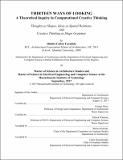| dc.contributor.advisor | George Stiny and Patrick Winston. | en_US |
| dc.contributor.author | Turakhia, Dishita Girish | en_US |
| dc.contributor.other | Massachusetts Institute of Technology. Department of Electrical Engineering and Computer Science. | en_US |
| dc.date.accessioned | 2018-03-02T21:39:09Z | |
| dc.date.available | 2018-03-02T21:39:09Z | |
| dc.date.copyright | 2017 | en_US |
| dc.date.issued | 2017 | en_US |
| dc.identifier.uri | http://hdl.handle.net/1721.1/113918 | |
| dc.description | Thesis: S.M., Massachusetts Institute of Technology, Department of Architecture, 2017. | en_US |
| dc.description | Thesis: S.M., Massachusetts Institute of Technology, Department of Electrical Engineering and Computer Science, 2017. | en_US |
| dc.description | This electronic version was submitted by the student author. The certified thesis is available in the Institute Archives and Special Collections. | en_US |
| dc.description | Cataloged from student-submitted PDF version of thesis. | en_US |
| dc.description | Includes bibliographical references (pages 97-99). | en_US |
| dc.description.abstract | The vision of this research is to propose a novel computational framework to study Creative Thinking. If we are to embed machines with creative thinking abilities, then we first need to study the evanescent nature of human creative thinking. Creative thinking is neither entirely random nor strictly logical, making it difficult to t its computation into structured logical models of thinking. Given this conundrum, how can we computationally study the process of thinking creatively? In this research, I first present the current scientific definitions of creative thinking. Through literary survey of cognitive, computational and design thinking frameworks, I identify the missing links between human creativity and AI models of creative thinking. I assert that creative thinking is result of two features of human intelligence, cognitive diversity and social interaction. Cognitive diversity or the ability to parse knowledge in dierent ways is a crucial aspect of creative thinking. Furthermore, social interaction between cognitively diverse individuals results in restructuring of thoughts leading to creativity and epiphanies (the aha moments). I posit that Shape Grammar, with its ability to fluidly restructure computation, can be used to study and demonstrate cognitive diversity and interaction. If we conceive thoughts as shapes and ideas as configurations of those shapes, then cognitive diversity can be described as rule-based computation on shapes to generate those configurations; and interaction as the exchange of rules between cognitive diverse entities (humans or machines). The contributions of this research are threefold. First, I present a literature review of current frameworks, and identify the two gaps between machine and human creativity. Secondly, I demonstrate how shape grammar can ll those gaps of cognitive diversity and interaction. Thirdly, I propose thought-shape framework that adapts principles of shape grammar for computational creative thinking. | en_US |
| dc.description.statementofresponsibility | by Dishita Girish Turakhia. | en_US |
| dc.format.extent | 99 pages | en_US |
| dc.language.iso | eng | en_US |
| dc.publisher | Massachusetts Institute of Technology | en_US |
| dc.rights | MIT theses are protected by copyright. They may be viewed, downloaded, or printed from this source but further reproduction or distribution in any format is prohibited without written permission. | en_US |
| dc.rights.uri | http://dspace.mit.edu/handle/1721.1/7582 | en_US |
| dc.subject | Architecture. | en_US |
| dc.subject | Electrical Engineering and Computer Science. | en_US |
| dc.title | Thirteen ways of looking : a theoretical inquiry in computational creative thinking | en_US |
| dc.title.alternative | Theoretical inquiry in computational creative thinking | en_US |
| dc.type | Thesis | en_US |
| dc.description.degree | S.M. | en_US |
| dc.contributor.department | Massachusetts Institute of Technology. Department of Architecture | |
| dc.contributor.department | Massachusetts Institute of Technology. Department of Electrical Engineering and Computer Science | |
| dc.identifier.oclc | 1023434010 | en_US |
